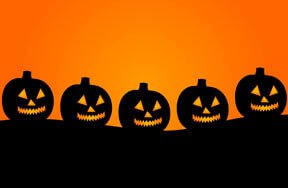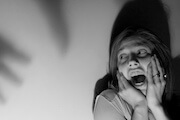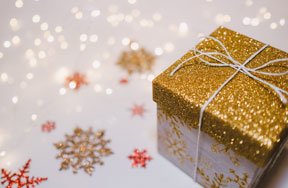Americans love celebrating Halloween. But did you know that Halloween began with an ancient culture over 2000 years ago?
The holiday began with the Celts, a group of people who lived in what today is the nation of Ireland and much of Europe. Back then, the holiday was an end-of-summer harvest feast called Samhain, pronounced Sow-en. Samhain also marked the Celts’ New Year. On October 31st, the Celts believed the boundary between the living and the dead became blurred. Druids, or Celtic priests, dressed up in costumes and had huge sacred bonfires. They wore animal heads and skins and believed they had special power to predict the future on this night.
 Some say the European tradition of dressing in costume and going from house to house to beg for soul cakes helped give birth to modern-day trick-or-treating.
Some say the European tradition of dressing in costume and going from house to house to beg for soul cakes helped give birth to modern-day trick-or-treating.
Ghosts. Ghouls. Goblins and….Fairies?
We don’t usually think of fairies as spooky Halloween creatures. However, if you traveled the streets of an ancient Irish village on the night of October 31st, you’d hide from them. On Samhain Eve, the Celts believed fairies and spirits came out of hiding and walked amongst them. They called fairies the “good folk,” but they also feared them—especially on this night.
 On Samhain Eve, the Celts believed fairies came out of hiding and walked among them.
On Samhain Eve, the Celts believed fairies came out of hiding and walked among them.
If you stole a glimpse of an Irish fairy, it might have looked like a tiny person, but some could change size and shape. Their dancing and beautiful music may have enchanted you—but watch out. Fairies had bad tempers. They got angry if you bothered them and spoiled their fun in the bushes and fields where they lived. If you crossed paths with fairies on Samhain Eve, you might have found them dancing with ghosts, playing pranks, and causing mischief. If you upset them, they may have brought nasty weather, spoiled your crops or kidnapped you to Fairyland. On Samhain Eve, the Celts feared the Pooka most of all. This mysterious type of fairy often appeared as a yellow-eyed black horse. It liked scaring people, taking them for wild rides, trampling their crops and spooking their farm animals.
 On Samhain Eve, the Celts believed a mysterious type of fairy, called the Pooka, often appeared as a yellow-eyed black horse.
On Samhain Eve, the Celts believed a mysterious type of fairy, called the Pooka, often appeared as a yellow-eyed black horse.
As a Celt, your village did all it could to protect itself from unkind fairies and ghosts on Samhain Eve. You left sweets out to keep them well-fed. Your leaders lit huge bonfires on hilltops to drive them away. You made sure your potatoes were dug, your oats stacked and your cattle brought in. If you left your house, you disguised yourself in a scary mask so that the real goblins thought you were one of them. You may have even marched in a freaky parade with your costumed neighbors, hoping to lead the spirits out of your village.
 What a Celtic farmer may have looked like. Halloween started among the Celts as an end-of-summer harvest feast called Samhain.
What a Celtic farmer may have looked like. Halloween started among the Celts as an end-of-summer harvest feast called Samhain.
Halloween Though The Centuries
As hundreds of years passed, people from other lands added their own traditions to Samhain. When Christianity spread to the British Isles, Samhain traditions combined with Roman and Christian influences. The Church created All Soul’s Day on November 2nd to blend with traditional Samhain customs. People went from house to house begging for soul cakes, and in return promised to pray for the dead. Some say this tradition helped give birth to modern-day trick-or-treating. The popular party game, apple-bobbing, probably came from the Roman feast of Pomona, the goddess of fruit and seeds.
 Bobbing for apples probably came from the Roman feast of Pomona, the goddess of fruit and seeds.
Bobbing for apples probably came from the Roman feast of Pomona, the goddess of fruit and seeds.
Samhain was renamed All Saint’s Day, or All Hallows Day. The night before this became All Hallows Eve, and then Halloween. Still, Samhain lived on in many ways. People throughout Europe continued to fear fairies, wear costumes and drive out ghosts on October 31st. They even carved candlelit turnips into eerie faces and placed them outside to keep spirits away—the first Jack O’ Lanterns.
 The first jack o' lanterns were made from turnips.
The first jack o' lanterns were made from turnips.
Halloween Today
When a flood of Irish immigrants came to America in the 19th century, Halloween became much more popular here. Today in America, even though we don’t spend Halloween hiding from fairies, we still carve Jack O’ Lanterns and offer sweets like people across the ocean did long ago. And each year when we disguise ourselves, we relive an ancient 2000-year-old tradition. So this time, when you step into your creepy costume, remember the ghosts, goblins, and especially the fairies of Ireland. After all, they helped invent one of America’s most-beloved holidays.
 Today, Halloween is celebrated in many different ways in different countries all over the world.
Today, Halloween is celebrated in many different ways in different countries all over the world.
Have a bite of history this Halloween with Soul Cakes!
Ingredients:
- 6 oz. butter
- 1 lb. all-purpose flour, sifted
- Milk, if necessary
- 6 oz. sugar
- A pinch mixed spice
- 3 egg yolks
- 2 1/2 oz. currants
Instructions:
- Preheat the oven to 350 degrees.
- Cream together butter and sugar.
- Beat the egg yolks one at a time into the butter and sugar mixture.
- Mix in the sifted flour and mixed spice, then fold in the currants. Add a little milk if the dough is too dry.
- Make 16 balls out of the dough. Place on the baking sheet, leaving at least an inch between each ball. Mark each one with a cross.
- Bake in the oven for 10 to 15 minutes.
 People used to make soul cakes for All Soul's Day
People used to make soul cakes for All Soul's Day
Share With Kidzworld
Do you celebrate Halloween? What’s your favorite costume of all-time? Tell us below!

































